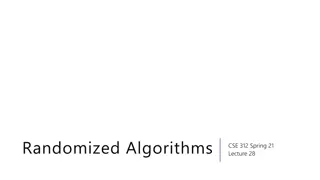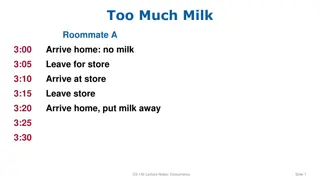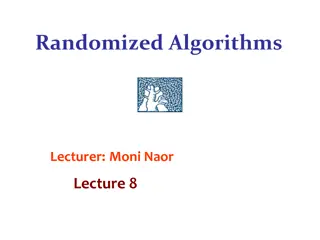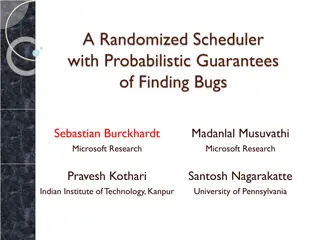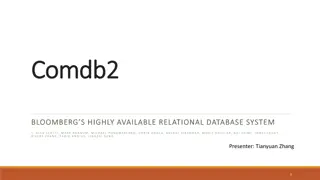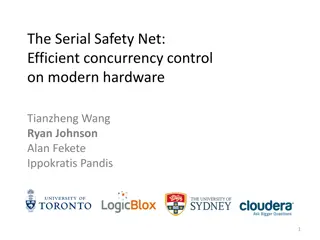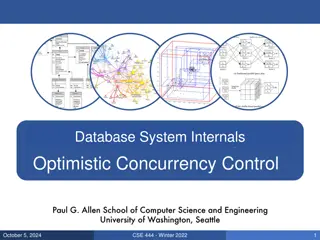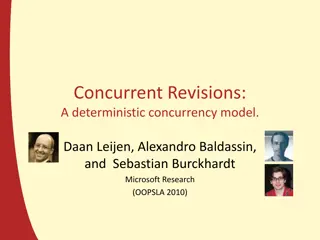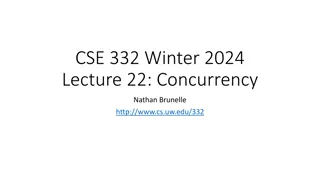Challenges and Solutions in Concurrency Testing with Randomized Algorithms
Concurrency testing in complex cloud services presents challenges such as bugs, performance problems, and data loss. Randomized algorithms, like Probabilistic Concurrency Testing (PCT), offer effective bug-finding solutions. PCT provides probabilistic guarantees and scalable bug detection for distributed systems, finding critical bugs efficiently. Leveraging hypothesis-driven design strategies enhances bug coverage, making random testing more effective. Verification vs. testing debates the efficacy of disciplined techniques over random methods in bug discovery.
Download Presentation

Please find below an Image/Link to download the presentation.
The content on the website is provided AS IS for your information and personal use only. It may not be sold, licensed, or shared on other websites without obtaining consent from the author.If you encounter any issues during the download, it is possible that the publisher has removed the file from their server.
You are allowed to download the files provided on this website for personal or commercial use, subject to the condition that they are used lawfully. All files are the property of their respective owners.
The content on the website is provided AS IS for your information and personal use only. It may not be sold, licensed, or shared on other websites without obtaining consent from the author.
E N D
Presentation Transcript
Randomized Algorithms For Concurrency Testing Madan Musuvathi Microsoft Research
Clouds services are complex Storage External Services Distributed Asynchronous Fault-prone Frontend Backend Fault-Tolerance Bugs Concurrency Bugs Performance problems Data loss Unavailability Data inconsistency
Amazon EC2 and Amazon RDS Service Disruption [2011] configuration change specific set of setps concurrency
Verification vs Testing = = proof search bug search
Random is effective! [Thomson et al. PPoPP 14, TOPC 16] PCT RAND CHESS DFS
Verification vs Testing = = proof search bug search 1. Can we design disciplined testing techniques ? 2. Can such techniques beat random testing & verification in finding bugs?
PCT: Probabilistic Concurrency Testing [ASPLOS 10] A randomized scheduler for finding concurrency bugs Probabilistic guarantees Every run finds every bug with nontrivial probability Repeated runs increase the chance of finding a bug Scalable In the no. of threads and program size
PCT status Literally a push button Ships as part of Application Verifier and Driver Verifier Finds bugs in well-tested software in its first run Testing with PCT is required for third-party driver verification Torch extension of PCT for distributed systems Work in progress Is finding ~5 critical bugs every week
Design strategy Hypothesis: bugs have simple root causes One reason why random testing is effective Classify bugs into classes of increasing complexity Design algorithms to efficiently cover bug classes 1. 2.
Classifying concurrency bugs Root cause of a bug = set of ordering constraints sufficient to find the bug ? ?, ? ?, ? ? Bug depth = size of the minimum such set
A Bug of Depth 1 Bug Depth = no. of ordering constraints sufficient to find the bug Possible schedules Parent Child A B C D E F G H I J A B F G H C D E I J A B F G C D E H I J A B F G C H D E I J A B F G H I J C D E A: B: fork (child); C: p = malloc(); D: E: F: . G: do_init(); H: p->f ++; I: J:
A Bug of Depth 2 Bug Depth = no. of ordering constraints sufficient to find the bug Possible schedules Parent Child A B C D E F G H I J A B C D E H I J F G A B C H I D E G J A B C D H E F I J G A B C H D E I J F G A: B: p = malloc(); C: fork (child); D: . E: if (p != NULL) F: p->f ++; G: H: I: p = NULL; J : .
Another Bug of Depth 2 Bug Depth = no. of ordering constraints sufficient to find the bug Parent Child A: B: Lock (A); C: D: Lock (B); E: F: G: Lock (B); H: I: Lock (A); J:
Formal definition of bug depth A system is defined by its set of executions ? Each execution is a sequence of labelled events A concurrency bug ? is some strict subset of ? A B C D E F G H I J A B F G H C D E I J ? ?
Formal definition of bug depth An ordering constraint ? is a pair of events ? = (? ?) A schedule s satisfies ? ? if ? occurs before ? in s ? ?1, ,?? = set of schedules that satisfy ?1, ,?? A B C D E F G H I J A B F G H C D E I J ? ? ?((? ?)) A B F G H C D E I J A B F G H I J C D E
Formal definition of bug depth A bug ? is of depth ? if there exists c1 ?? such that ? ?1, ,?? ? and ? is the smallest such for ? A B C D E F G H I J A B F G H C D E I J ? ? ?((? ?)) A B F G H C D E I J A B F G H I J C D E
Finding all bugs of depth d A set of schedules ?covers all bugs of depth ? if ?1, ,?? ? ?1, ,?? ? ? Coverage problem: find the smallest such ? ?((? ?)) ?((? ?)) ? ?((? ?)) ?((? ?)) ?((? ?))
Lets study when ? = 1 Need to cover all of: g b b g a h b b h b g g c c g h c c h c h g e e g e i h e e h f i e e i
Lets study when ? = 1 Need to cover all of: g b b g a h b b h b g g c c g h c c h c h g e e g e i h e e h f i e e i Two interleavings are sufficient! a b c e g h i f a g h b c i e f
Dimension Theory Any partial-order G can be expressed as an intersection of a set of total orders This set is called a realizer of G a a b c d e = b d a d b e c c e For any unordered pair ?,? a realizer contains two total orders that cover both ? ?, ? ? Dimension of G, ??? ? is the size of the smallest realizer of G [Dushnik & Miller 41]
Encoding a partial-order in d-dimensions c 4 a e 3 = b d b 2 c e d 1 a 0 a b c d e 0 1 2 3 4 a d b e c
Solving the coverage problem for ? = 2 Assume ?, the set of all executions of a program is the set of all linearizations of some partial order ? Find a realizer ? of size ???(?) ? finds all bugs of depth 2 Two problems: The assumption above does not hold in practice Finding the ???(?) is NP-hard [Yannakakis 82]
Width of a Partial-Order The minimum number of total orders needed to cover G Width corresponds to the number of threads in G a a b d b d is covered by c e c e ? dim ? ???? ? ??:dim ?? = ???? ?? = ?
Lets study when ? = 1 Need to cover all of: g b b g a h b b h b g g c c g h c c h c h g e e g e i h e e h f i e e i A realizer of size width(G) = 2 a b c e g h i f a g h b c i e f
Lets study when ? = 1 g b b g a h b b h b g g c c g h c c h c h g e e g e i h e e h f i e e i a b c e g h i f a g h b c i e f
Solving the coverage problem for ? = 2 Assume the program has ? threads For each thread ? generate an execution with ? as the lowest priority ? runs only when all other threads are blocked The ? executions above find all bugs of depth PCT algorithm uniformly samples from this set
PCT algorithm for ? = 2 Each thread gets a random priority Run the highest-priority enabled thread at each step A parallel PCT [PLDI 12] only blocks the lowest priority thread Note: the algorithm is online does not require the partial-order to be presented in its entirely
Extending dimension theory for ? > 2 A ?-realizer of ? covers every set of ? ordering constraints ?1 ?? Proof: every partial order ? has a ?-realizer of size 1 ? ?? 1 where ? = ???? ? and ? = |?| PCT is a randomized algorithm for uniformly sampling such a realizer
PCT Algorithm Inputs: n: estimated bound on the number of threads k: estimated bound on the number of steps d: target bug depth // 1. assign random priorities >= d to threads for t in [1 n] do priority[t] = rand() + d; // 2. chose d-1 lowering points at random for i in [1...d) do lowering[i] = rand() % k; steps = 0; while (some thread enabled) { // 3. Honor thread priorities Let t be the highest-priority enabled thread; schedule t for one step; steps ++; // 4. At the ith lowering point, set the priority to i if steps == lowering[i] for some i priority[t] = i; }
PCT guarantee PCT finds every bug of depth ? in every run with probability at least ? ?? 1 1 where ? is the max. no. of threads and ? is the max. no. of instructions in an execution
Comparison with Worst-Case Bound Program Empirical Bound Splash Barnes 0.5 0.5 Splash LU 0.5 0.5 Splash- Barnes 0.49 0.5 Pbzip 0.701 0.0001 Work Steal Queue 0.002 0.0003 2x10-5 Dryad 0.164
Open challenges Dimension theory for d constraints is largely unstudied No known lower-bound for the size of a d-realizer Scalability of PCT is limited by its dependence on ?? 1 Need to incorporate fairness Consistently slowing down the low-priority thread can cause starvation + application timeouts
Hitting Families [Dmitry et al. CAV 2016] Studied covering constraints of the form ? ? ? ? (as opposed to ? ?,? ?,? ?) In trees a b c d e f g h i dim ???? = 2 ???? (????)
Hitting families Key results: Antichains with k elements have hitting families of size ?(exp ? log?) (non constructive proof) Trees with height h 4h schedules cover ? ? ? constraints ?(exp ? ? 1) schedules cover ?1 ?2 ?? Need constructive online versions of these algorithms
Generalization to Fault Injection Testing Recent work by Filip Niksic & Rupak Majumdar Efficiently inject faults to cover all interesting network partitions




